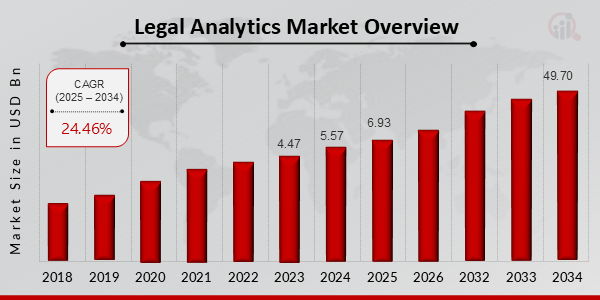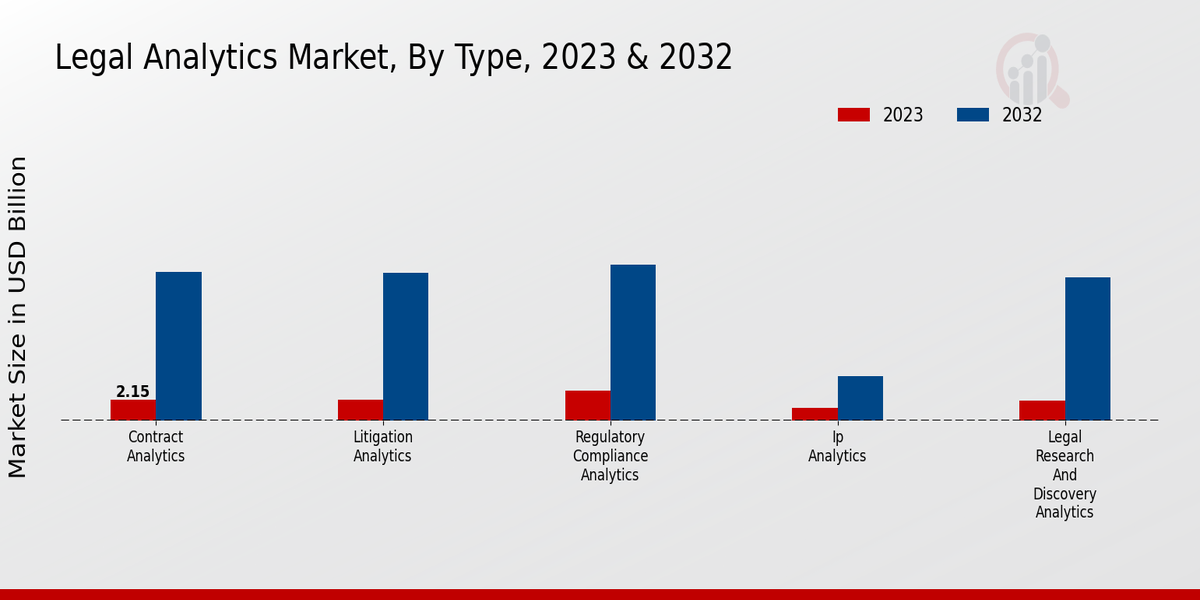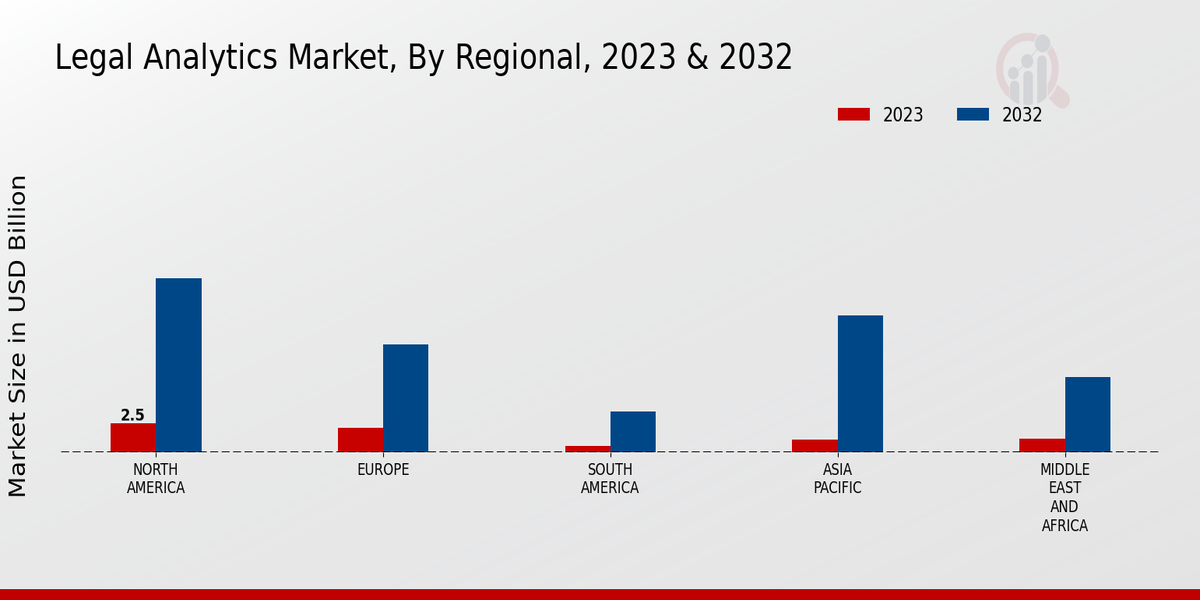Legal Analytics Market Overview
Legal Analytics Market is projected to grow from USD 6.93 Billion in 2025 to USD 49.70 Billion by 2034, exhibiting a compound annual growth rate (CAGR) of 24.46% during the forecast period (2025 - 2034). Additionally, the market size for Legal Analytics Market was valued at USD 5.57 billion in 2024.
Key Legal Analytics Market Trends Highlighted
The Legal Analytics Market is experiencing significant growth, driven by the increasing volume and complexity of legal data, the need for improved efficiency and cost optimization, and the rise of artificial intelligence (AI) and machine learning (ML) technologies. Legal analytics tools enable law firms, corporate legal departments, and government agencies to analyze and interpret vast amounts of legal data, providing insights into case outcomes, legal trends, and potential risks.
The market is also witnessing a surge in the adoption of cloud-based legal analytics solutions, offering scalability, cost-effectiveness, and accessibility. The application of AI and ML algorithms in legal analytics tools is further enhancing their capabilities, automating tasks, and improving accuracy. Additionally, the growing adoption of legal analytics in areas such as e-discovery, contract review, and risk management presents ample opportunities for market growth.
Figure 1: Legal Analytics Market Size, 2025-2034 (USD Billion)

Source: Primary Research, Secondary Research, MRFR Database and Analyst Review
Legal Analytics Market Drivers
Increased Need for Legal Efficiency and Cost Reduction
The legal industry is facing increasing pressure to improve efficiency and reduce costs. Legal analytics can help law firms and corporate legal departments do this by automating tasks, improving decision-making, and identifying inefficiencies.
For example, legal analytics can be used to automate document review and analysis, identify patterns and trends in legal data, predict the outcome of legal cases, optimize legal spend, and improve compliance with legal regulations. By leveraging legal analytics, law firms and corporate legal departments can improve their efficiency, reduce costs, and gain a competitive advantage.
Growing Volume and Complexity of Legal Data
The amount of legal data, as well as its complexity, is constantly growing. There is a range of reasons for such a tendency, including the increasing use of electronic documents, business globalization, legal globalization, and the ongoing production of new statutes, judgments, and precedents.
The growing volume of data makes it complicated for law firms and corporative legal departments to manage and analyze the data they have. Legal analytics grants law firms and corporative legal departments access to the tools and technologies they require to leverage their data to manage and analyze it more effectively.
Legal analytics can assist in organizing and storing legal data, searching and retrieving legal data, analyzing legal data, and visualizing legal data. Using legal analytics, law firms and corporate legal departments can substantially enhance their capacity to manage and analyze data, which should result in making better data-driven decisions and improving the quality and mechanisms of legal service provisions.
Advancements in Artificial Intelligence (AI) and Machine Learning (ML)
Advancements in AI and ML are having a major impact on the legal industry. AI and ML can be used to automate tasks, improve decision-making, and identify inefficiencies. For example, AI and ML can be used to automate document review and analysis, identify patterns and trends in legal data, predict the outcome of legal cases, optimize legal spend, and improve compliance with legal regulations. By leveraging AI and ML, law firms and corporate legal departments can improve their efficiency, reduce costs, and gain a competitive advantage.
Legal Analytics Market Segment Insights:
Legal Analytics Market Type Insights
The Legal Analytics Market is segmented by type into contract analytics, litigation analytics, regulatory compliance analytics, IP analytics, and legal research and discovery analytics. Among these segments, contract analytics is expected to hold the largest market share during the forecast period.
The growth of contract analytics can be attributed to the increasing adoption of contract analytics solutions by legal professionals to automate and streamline the contract review process. Litigation Analytics is another major segment that is expected to witness significant growth in the coming years. The increasing use of data analytics in litigation to identify patterns, predict outcomes, and develop winning strategies is driving the growth of this segment.
Regulatory compliance analytics is also expected to grow steadily during the forecast period, as organizations look for ways to automate and improve their compliance processes. The growth of this market can be attributed to the increasing adoption of legal analytics solutions by law firms, corporate legal departments, and government agencies.
Legal analytics solutions can help legal professionals to improve their efficiency, accuracy, and decision-making. The growing volume of legal data is also driving the growth of this market, as legal professionals look for ways to manage and analyze this data to gain insights.

Source: Primary Research, Secondary Research, MRFR Database and Analyst Review
Legal Analytics Market Deployment Model Insights
The Legal Analytics Market is segmented based on deployment model into on-premise, cloud, and hybrid. Among these, the cloud segment is anticipated to hold the largest market share and is projected to grow at a CAGR of 28.5% during the forecast period.
The growth of the cloud segment can be attributed to the increasing adoption of cloud-based legal software and services by law firms and corporate legal departments. Cloud-based deployment offers several benefits such as scalability, flexibility, cost-effectiveness, and ease of use, which is driving its adoption.
The on-premise segment is expected to hold a significant market share due to the preference of some organizations for on-premise solutions for security and data control reasons. The hybrid segment is gaining traction as it combines the benefits of both on-premise and cloud deployments, allowing organizations to customize their solutions based on their specific requirements.
Legal Analytics Market Legal Process Insights
The legal process segment is projected to witness substantial growth over the forecast period due to the increasing adoption of legal analytics solutions to streamline and improve the efficiency of legal processes.
Contract management is a key area of focus, with solutions being used to automate contract review, negotiation, and management, leading to significant cost and time savings, this segment is expected to reach USD 7.80 billion in revenue by 2024, registering a CAGR of 26.3%.
Litigation management is another major segment, with solutions used to manage complex litigation cases, reduce costs, and improve outcomes. The regulatory compliance management segment is growing due to the increasing regulatory pressure on organizations, leading to the need for compliance analytics solutions to automate compliance processes and reduce risk.
The mergers and acquisitions segment is driven by the growing number of transactions and the need for legal analytics to support due diligence, integration planning, and post-merger compliance. The Corporate Governance segment is also witnessing growth as organizations seek to improve their governance practices and mitigate risks using legal analytics solutions.
Legal Analytics Market Organization Size Insights
The Legal Analytics Market segmentation by organization size includes small and medium-sized enterprises (SMEs) and large enterprises. The large enterprises segment held a larger market share in 2023 and is projected to continue its dominance throughout the forecast period.
This can be attributed to the increasing adoption of legal analytics solutions by large enterprises to manage their complex legal operations, reduce costs, and gain a competitive advantage. SMEs, on the other hand, are expected to witness a significant growth rate during the forecast period due to the increasing awareness of legal analytics benefits and the availability of affordable solutions tailored to their needs.
The Legal Analytics Market revenue for the large enterprises segment is projected to reach USD 18.6 billion by 2032, growing at a CAGR of 23.4%, while the SMEs segment is expected to reach USD 7.2 billion by 2032, growing at a CAGR of 25.8%.
Legal Analytics Market Regional Insights
The market is segmented into various regions, including North America, Europe, APAC, South America, and MEA. North America is the largest regional segment, accounting for a significant share of the Legal Analytics Market revenue. The region has a well-established legal system and a high adoption rate of legal analytics solutions.
Europe is another key regional segment, with a growing demand for legal analytics solutions due to the increasing complexity of legal processes. The APAC region is expected to witness the highest growth rate during the forecast period, driven by the increasing adoption of legal analytics solutions in emerging markets such as China and India. South America and MEA are also expected to experience significant growth in the coming years, as legal analytics solutions become more widely adopted in these regions.

Source: Primary Research, Secondary Research, MRFR Database and Analyst Review
Legal Analytics Market Key Players and Competitive Insights:
Major players in the legal analytics market are continuously focusing on the development of innovative solutions to meet the evolving demands of the legal profession. Leading players such as LexisNexis, Thomson Reuters, Kira Systems, and Casetext are investing heavily in research and development to enhance their offerings. This competitive landscape is expected to drive legal analytics market development and innovation in the coming years.
An important market player in this domain is LexisNexis. The company offers a comprehensive suite of legal analytics solutions, including LexisNexis CounselLink, LexisNexis InterAction, and LexisNexis Visual Analytics. These solutions provide lawyers with access to a vast repository of legal data, enabling them to make informed decisions and improve their efficiency. LexisNexis has a strong global presence and serves a diverse client base, including law firms, corporations, and government agencies.
Another competitor in the legal analytics market is Thomson Reuters. The company offers a range of legal analytics solutions, including Westlaw Edge, Practical Law, and HighQ. These solutions are designed to help lawyers research legal issues, draft documents, and manage their cases. Thomson Reuters has a strong reputation for providing high-quality legal content and analytics, and it serves a wide range of clients, including law firms, corporations, and government agencies.
Key Companies in the Legal Analytics Market Include:
- Ravel Law
- ROSS Intelligence
- LexisNexis
- Kira Systems
- Neota Logic
- ThoughtRiver
- Casetext
- Lex Machina
- Docket Navigator
- Judicata
- Legalsifter
- Seal Software
- Westlaw
- Thomson Reuters
- Gavelytics
Legal Analytics Market Developments
The Legal Analytics Market is projected to grow from USD 3.6 billion in 2023 to USD 25.8 billion by 2032, exhibiting a CAGR of 24.46% during the forecast period (2024-2032). Key factors driving the market growth include increasing adoption of artificial intelligence (AI) and machine learning (ML) in legal processes, rising demand for data-driven insights to improve legal strategies, and growing need for efficient and cost-effective legal services.
Recent developments in the market include the launch of new AI-powered legal research tools, strategic partnerships between legal tech companies and law firms, and increasing investments in legal analytics solutions.
Legal Analytics Market Segmentation Insights
Legal Analytics Market Type Outlook
- Contract Analytics
- Litigation Analytics
- Regulatory Compliance Analytics
- IP Analytics
- Legal Research and Discovery Analytics
Legal Analytics Market Deployment Model Outlook
Legal Analytics Market Legal Process Outlook
- Contract Management
- Litigation Management
- Regulatory Compliance Management
- Mergers and Acquisitions
- Corporate Governance
Legal Analytics Market Organization Size Outlook
- Small and Medium-sized Enterprises (SMEs)
- Large Enterprises
Legal Analytics Market Regional Outlook
- North America
- Europe
- South America
- Asia Pacific
- Middle East and Africa
| Report Attribute/Metric |
Details |
|
Market Size 2024
|
5.57 (USD Billion)
|
|
Market Size 2025
|
6.93 (USD Billion)
|
|
Market Size 2034
|
49.70 (USD Billion)
|
|
Compound Annual Growth Rate (CAGR)
|
24.46% (2025 - 2034)
|
|
Report Coverage
|
Revenue Forecast, Competitive Landscape, Growth Factors, and Trends
|
|
Base Year
|
2024
|
|
Market Forecast Period
|
2025 - 2034
|
|
Historical Data
|
2019 - 2023
|
|
Market Forecast Units
|
USD Billion
|
| Key Companies Profiled |
Ravel Law, ROSS Intelligence, LexisNexis, Kira Systems, Neota Logic, ThoughtRiver, Casetext, Lex Machina, Docket Navigator, Judicata, Legalsifter, Seal Software, Westlaw, Thomson Reuters, Gavelytics |
| Segments Covered |
Type, Deployment Model, Legal Process, Organization Size, Region |
| Key Market Opportunities |
1. AI-powered Legal Research 2. Predictive Analytics for Litigation 3. Legal Process Automation 4. Compliance Risk Management 5. Data-driven Legal Decision Making |
| Key Market Dynamics |
1. Growing Adoption of AI 2. Cloud-based Deployment 3. Increasing Litigation Costs 4. Regulatory Compliance 5. Data Security Concerns |
| Countries Covered |
North America, Europe, APAC, South America, MEA |
Frequently Asked Questions (FAQ) :
The legal analytics market is estimated to reach a valuation of 6.93 billion USD in 2025 and is projected to grow to 49.70 billion USD by 2034, exhibiting a CAGR of 24.46%.
North America holds the largest share in the market, owing to the presence of many legal firms and the increasing adoption of technology in the legal industry.
Key growth drivers include the increasing volume of legal data, the need for improved efficiency in legal processes, and the growing adoption of artificial intelligence (AI) in the legal industry.
Major applications of legal analytics include predictive analytics, risk assessment, legal research, and document review.
Key competitors in the market include LexisNexis, Thomson Reuters, Wolters Kluwer, and IBM.
The Legal Analytics Market is anticipated to exhibit a CAGR of 24.46% from 2024 to 2032.
Challenges faced by the market include data privacy concerns, the need for skilled professionals, and the high cost of implementation.
Opportunities for growth include increasing adoption of AI in the legal industry, growing demand for legal analytics solutions in emerging markets, and development of new applications for legal analytics.
Key trends shaping the market include the increasing use of cloud-based solutions, the adoption of machine learning (ML) algorithms, and the growing focus on data visualization.
Legal analytics is expected to transform the legal industry by improving efficiency, reducing costs, and providing new insights into legal data.

















